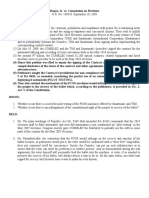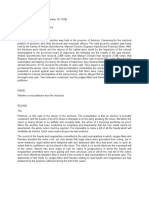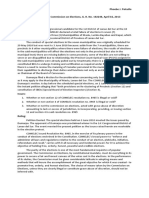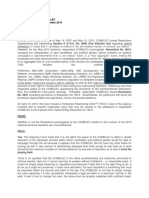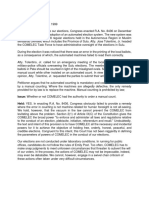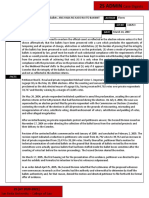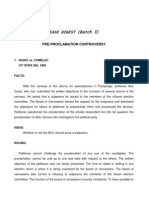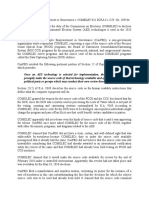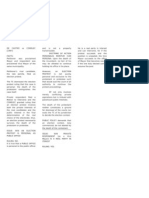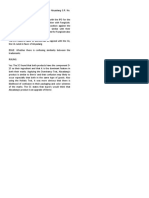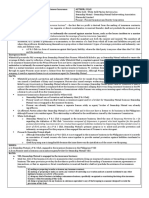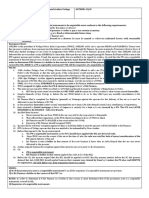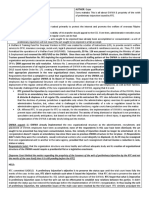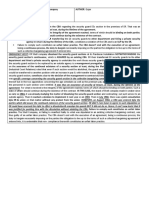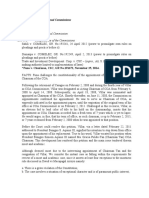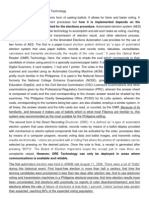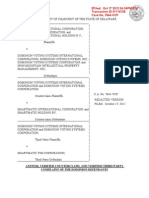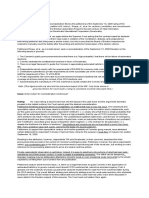14 - Roque vs. COMELEC Digest
14 - Roque vs. COMELEC Digest
Uploaded by
Krizzia GojarCopyright:
Available Formats
14 - Roque vs. COMELEC Digest
14 - Roque vs. COMELEC Digest
Uploaded by
Krizzia GojarOriginal Title
Copyright
Available Formats
Share this document
Did you find this document useful?
Is this content inappropriate?
Copyright:
Available Formats
14 - Roque vs. COMELEC Digest
14 - Roque vs. COMELEC Digest
Uploaded by
Krizzia GojarCopyright:
Available Formats
Roque, Jr. vs.
Commission on Elections
G.R. No. 188456. September 10, 2009
FACTS:
(1) Petitioners filed a petitioner for certiorari, prohibition and mandamus with
prayer for a restraining order and/or preliminary injunction and are suing as
taxpayers and concerned citizens. They seek to nullify respondent
COMELECs award of the 2010 Elections Automation Project to the joint
venture of Total Information Management Corporation (TIM) and
Smartmatic International Corporation (Smartmatic)1 and to permanently
prohibit the Comelec, TIM and Smartmatic from signing and/or
implementing the corresponding contract-award.
(2) On Dec 22, 1997 Congress enacted RA 8346 authorizing the adoption of an
automated election system (AES) in the May 11, 1998 national and local
elections and onwards. However during 1998, 2001 and 2004, purely
manual elections were done.
(3) On Jan 23, 2007, the amendatory of RA 9369 was passed authorizing again
the COMELEC to use the AES. Sec 5 of that law authorised the COMELEC
to:
Use an automated election system or systems in the same election in different
provinces, whether paper-based or a direct recording automated election system as it
may deem appropriate and practical for the process of voting, counting of votes and
canvassing/consolidation and transmittal of results of electoral exercises: Provided,
that for the regular national and local election, which shall be held immediately after
effectivity of this Act, the AES shall be used in at least two highly urbanized cities
and two provinces each in Luzon, Visayas and Mindanao, to be chosen by the
Commission x x x x In succeeding regular national or local elections, the AES shall
be implemented nationwide.
(4) However, the COMELEC did not use any AES in the May 14 2007
elections.
(5) On July 19, 2009, the COMELEC and the TIM and Smartmatic (provider)
signed the contract for the automated tallying and recording of votes cast
nation-wide in the May 2010 elections.
(6) For around P7 billion, the COMELEC leased 82,200 optical scanners,
related equipment and hired ancillary services provider to be used in the
May 2010 elections.
(7) Hence this petition was filed to enjoin the signing of the Contract or its
implementation and to compel disclosure of the terms of the contract and
other agreements between the provider and its subcontractors.
(8) Petitioners sought the Contract's invalidation for non-compliance with the
requirement in Section 5 of RA 8436, as amended, mandating the partial use
of an automated election system before deploying it nationwide.
To further support their claim on the Contract's invalidity, petitioners alleged that:
(1) the optical scanners leased by the COMELEC do not satisfy the minimum
systems capabilities" under RA 8436, as amended (he was claiming that the
COMELEC must pilot test in 12 areas in the country in the national
elections of 2010, before doing fully computerized elections in the national
elections after 2010)
(2) the Provider not only failed to submit relevant documents during the
bidding but also failed to show "community of interest" among its
constituent corporations as required in Information Technology Foundation
of the Philippines v. COMELEC (Infotech).
ISSUE:
Is there a need for pilot testing of the PCOS machines offered by
Smartmatic and TIM? NO.
Was there an invalid joint venture agreement between COMELEC and the
provider during the bidding that would be in violation of the SCs holding in
the Information Technology Foundation of the Philippines v. COMELEC
(Infotech) which requires a joint venture to include a copy of its JVA
DURING the bidding? NONE
Was there an infringement of the constitutional right of the people to
secrecy of the ballot? NONE
HELD:
Pilot testing
The plain wordings of Republic Act No. 9369 (that amended RA 8436)
commands that the 2010 elections shall be fully automated, and such full
automation is not conditioned on pilot testing in the May 2007 elections.
Congress merely gave COMELEC the flexibility to partially use the AES in
some parts of the country for the May 2007 elections.
Any lingering doubt on the issue of whether or not full automation of the
2010 regular elections can validly proceed without a pilot run of the
Automated Election System (AES) should be put to rest with the enactment
in March 2009 of Republic Act No. 9525, in which Congress appropriated
PhP 11.301 billion to automate the 2010 electionsthe Republic Act No.
9525 is a compelling indication that it was never Congress intent to make
the pilot testing of a particular automated election system in the 2007
elections a condition precedent to its use or award of the 2010 Automation
Project.
Joint venture
As petitioners observed, that the TIM- Smartmatic joint venture remained
an unincorporated aggroupment during the bid- opening and evaluation
stages. It ought to be stressed, however, that the fact of non-incorporation
was without a vitiating effect on the validity of the tender offers.
For the bidding ground rules, as spelled out primarily in the RFP and the
clarificatory bid bulletins, does not require, for bidding purposes, that there
be an incorporation of the bidding joint ventures or consortiums
In fact, Bid Bulletin Nos. 19 and 20 recognize the existence and the
acceptability of proposals of unincorporated joint ventures. In response to a
poser, for example, regarding the 60% Filipino ownership requirement in a
joint venture arrangement, the SBAC, in its Bid Bulletin No. 22, stated:
As to petitioners contention that the PCOS would infringe on the secrecy and
sanctity of the ballot because the voter would be confronted with a three feet long
ballot:
As to the issue of the possible violation of the Anti Dummy Law given that the RFP
requirement of a joint venture bidder to be at least be 60% Filipino:
In an unincorporated joint venture, determination of the required Filipino
participation may be made by examining the terms and conditions of the [JVA] and
other supporting financial documents submitted by the joint venture.
And the Court held that petitioners have not shown that incorporation is part
of the pass/fail criteria used in determining eligibility
Infringement on secrecy and sanctity of the ballot and the possible violation of
the Anti-Dummy Law
Petitioners were contending that the COMELEC relinquished its
supervision and control of the system to be used for the automated elections
since the COMELEC would not be the one holding possession of the public
and private keys pair of the machines.
But Court held that the role of Smartmatic TIM Corporation is basically to
supply the goods necessary for the automation project, such as but not
limited to the PCOS machines, PCs, electronic transmission devices and
related equipment, both hardware and software, and the technical services
pertaining to their operation.
As lessees of the goods and the back-up equipment, the corporation and its
operators would provide assistance with respect to the machines to be used
by the Comelec which, at the end of the day, will be conducting the election
thru its personnel and whoever it deputizes. And if only to emphasize a
point, Comelecs contract is with Smartmatic TIM Corporation of which
Smartmatic is a 40% minority owner, per the JVA of TIM and Smartmatic
and the Articles of Incorporation of Smartmatic TIM Corporation.
Accordingly, any decision on the part or on behalf of Smartmatic will not be
binding on Comelec. As a necessary corollary, the board room voting
arrangement that Smartmatic and TIM may have agreed upon as joint
venture partners, inclusive of the veto vote that one may have power over
the other, should really be the least concern of the Comelec.
The Court held that, surely, the Comelec could put up such infrastructure as
to insure that the voter can write his preference in relative privacy. And as
demonstrated during the oral arguments, the voter himself will personally
feed the ballot into the machine. A voter, if so minded to preserve the
secrecy of his ballot, will always devise a way to do so. By the same token,
one with least regard for secrecy will likewise have a way to make his vote
known.
The winning bidder, TIM-Smartmatic joint venture, has Smartmatic, a
foreign corporation, owning 40% of the equity in, first, the joint venture
partnership, and then in Smartmatic TIM Corporation.
The Anti-Dummy Law has been enacted to limit the enjoyment of certain
economic activities to Filipino citizens or corporations. For liability for
violation of the law to attach, it must be established that there is a law
limiting or reserving the enjoyment or exercise of a right, franchise,
privilege, or business to citizens of the Philippines or to corporations or
associations at least 60 per centum of the capital of which is owned by such
citizens.
In the case at bench, the Court is not aware of any constitutional or statutory
provision classifying as a nationalized activity the lease or provision of
goods and technical services for the automation of an election. In fact, Sec.
8 of RA 8436, as amended, vests the Comelec with specific authority to
acquire AES from foreign sources, thus:
SEC 12. Procurement of Equipment and Materials.To achieve the purpose of
this Act, the Commission is authorized to procure, xxx, by purchase, lease, rent
or other forms of acquisition, supplies, equipment, materials, software,
facilities, and other services, from local or foreign sources xxx.
Petitioners cite Executive Order No. (EO) 584,98 Series of 2006,
purportedly limiting contracts for the supply of materials, goods and
commodities to government- owned or controlled corporation, company, agency or
municipal corporation to corporations that are 60% Filipino.
But the Court did not see the governing relevance of EO 584. For let alone
the fact that RA 9369 is, in relation to EO 584, a subsequent enactment and,
therefore, enjoys primacy over the executive issuance, the Comelec does
fall under the category of a government-owned and controlled corporation,
an agency or a municipal corporation contemplated in the executive order.
You might also like
- D&A: 06102006 Carolyn B. Maloney Letter To Henry M. Paulson, Jr.Document2 pagesD&A: 06102006 Carolyn B. Maloney Letter To Henry M. Paulson, Jr.D&A Investigations, Inc.No ratings yet
- Joint Complaint Affidavit Filed by Some Citizens vs. ComelecDocument40 pagesJoint Complaint Affidavit Filed by Some Citizens vs. ComelecBlogWatch100% (3)
- Akbayan-Youth v. ComelecDocument2 pagesAkbayan-Youth v. ComelecRaymond Roque100% (1)
- Subic Bay Metropolitan Authority V COMELECDocument2 pagesSubic Bay Metropolitan Authority V COMELECGretch Mary100% (1)
- The Technical Violations of Smartmatic-TIM AES Contract FromDocument25 pagesThe Technical Violations of Smartmatic-TIM AES Contract FromRG Cruz100% (2)
- Dominion and Smartmatic ResearchDocument22 pagesDominion and Smartmatic ResearchJack Duke100% (1)
- Roque v. COMELEC, G.R. No. 188456, September 10, 2009Document1 pageRoque v. COMELEC, G.R. No. 188456, September 10, 2009loschudentNo ratings yet
- 102 - Roque v. COMELEC, G.R. No. 188456Document2 pages102 - Roque v. COMELEC, G.R. No. 188456Carie Lawyerr33% (3)
- Roque Vs Commission On Elections DigestDocument2 pagesRoque Vs Commission On Elections Digestgnrslash01No ratings yet
- Elec Midterms DigestsDocument25 pagesElec Midterms DigestsMegan MateoNo ratings yet
- Elec Finals Digests MateoDocument15 pagesElec Finals Digests MateoMegan Mateo100% (1)
- Roque V ComelecDocument6 pagesRoque V ComelecSean Galvez100% (1)
- Badelles v. CabiliDocument2 pagesBadelles v. CabiliRaymond Roque33% (3)
- Gma Network v. ComelecDocument8 pagesGma Network v. ComeleckathrynmaydevezaNo ratings yet
- Villaber Vs COMELECDocument2 pagesVillaber Vs COMELECLeah Marie Sernal100% (4)
- Ututalum Vs Comelec (Digest)Document2 pagesUtutalum Vs Comelec (Digest)Aldin Lucena Aparecio100% (1)
- Garchitorena Vs CresciniDocument1 pageGarchitorena Vs Crescinistephcllo100% (2)
- Case Digest On Election LawDocument40 pagesCase Digest On Election Lawmarezaambat77% (13)
- Salic Dumarpa vs. Commission On Elections, G. R. No. 192249, April 02, 2013 (Case Digest)Document1 pageSalic Dumarpa vs. Commission On Elections, G. R. No. 192249, April 02, 2013 (Case Digest)Deanne Mitzi SomolloNo ratings yet
- GMA Network vs. ComelecDocument2 pagesGMA Network vs. Comeleckristinevillanueva100% (3)
- Dumayas V ComelecDocument6 pagesDumayas V ComelecCarie LawyerrNo ratings yet
- Gma vs. ComelecDocument2 pagesGma vs. ComelecJay-r Tumamak100% (2)
- Jalosjos V Comelec, GR 191970Document5 pagesJalosjos V Comelec, GR 191970JNMGNo ratings yet
- Soliva Vs ComelecDocument2 pagesSoliva Vs Comelecis_still_artNo ratings yet
- Caasi VS CaDocument1 pageCaasi VS CaaxvxxnNo ratings yet
- Villafuerte vs. COMELEC DigestDocument2 pagesVillafuerte vs. COMELEC DigestAbbot Reyes100% (2)
- Election Law Case Digests CompilationDocument182 pagesElection Law Case Digests CompilationYza G.No ratings yet
- Federico VS ComelecDocument3 pagesFederico VS Comelecgrace100% (1)
- DIGEST-Sinaca vs. MulaDocument1 pageDIGEST-Sinaca vs. MulaRhett Gaerlan100% (3)
- SC PIO Summary of Jalosjos v. COMELEC, G.R. No. 205033, June 18, 2013Document3 pagesSC PIO Summary of Jalosjos v. COMELEC, G.R. No. 205033, June 18, 2013The Supreme Court Public Information Office100% (1)
- CenPEG Vs ComelecDocument2 pagesCenPEG Vs ComelecJames CullaNo ratings yet
- 2E1617 ADMIN Pascasio Case Digests Moya v. Del Fierro To Miranda v. Abaya 1Document138 pages2E1617 ADMIN Pascasio Case Digests Moya v. Del Fierro To Miranda v. Abaya 1Zarah Canlas100% (1)
- Akbayan Youth V COMELEC G.R No. 147066, March 26, 2001 Buena, JDocument2 pagesAkbayan Youth V COMELEC G.R No. 147066, March 26, 2001 Buena, Jsmtm06100% (2)
- Elec Notes (Atty Gallant)Document62 pagesElec Notes (Atty Gallant)Emma RanNo ratings yet
- Cerafica v. ComelecDocument3 pagesCerafica v. ComelecEscanor GrandineNo ratings yet
- Mapala Vs NunezDocument1 pageMapala Vs NunezMaggieNo ratings yet
- Jaramilla Vs COMELECDocument1 pageJaramilla Vs COMELECRhett GaerlanNo ratings yet
- Loong v. Comelec DIGESTDocument1 pageLoong v. Comelec DIGESTApril0% (1)
- 9.admin Rosal Vs ComelecDocument4 pages9.admin Rosal Vs Comelecmichelle zatarain100% (1)
- Election Law Case DigestDocument15 pagesElection Law Case DigestRodilo SantinoNo ratings yet
- 085 - Cerafica V COMELECDocument3 pages085 - Cerafica V COMELECDaine BascoNo ratings yet
- Angobung Vs ComelecDocument3 pagesAngobung Vs Comeleckayelaurente100% (1)
- Sango-Asistio V. Aguirre-Domicile V. ResidenceDocument2 pagesSango-Asistio V. Aguirre-Domicile V. ResidenceNapoleon Sango IIINo ratings yet
- Digest - Binay Vs DomingoDocument1 pageDigest - Binay Vs DomingoPaolo BrillantesNo ratings yet
- Cerafica vs. ComelecDocument2 pagesCerafica vs. ComelecJay-r TumamakNo ratings yet
- Election Law DigestDocument12 pagesElection Law DigestsirodyojNo ratings yet
- Timbol Vs COMELECDocument2 pagesTimbol Vs COMELECKeilah Arguelles100% (2)
- 01 Pangkat Laguna Vs COMELECDocument2 pages01 Pangkat Laguna Vs COMELECOlivia Jane100% (1)
- G.R. No. 191124 April 27, 2010 Luis A. Asistio vs. Hon. Thelma Canlas Trinidad-Pe Aguirre FactsDocument6 pagesG.R. No. 191124 April 27, 2010 Luis A. Asistio vs. Hon. Thelma Canlas Trinidad-Pe Aguirre FactsKhayzee AsesorNo ratings yet
- Talaga Vs ComelecDocument3 pagesTalaga Vs ComelecYvonne Bioyo-Tulang100% (2)
- Election Law Cases Batch 1Document10 pagesElection Law Cases Batch 1Darlene GanubNo ratings yet
- Domino vs. ComelecDocument2 pagesDomino vs. ComelecKristine Joy Magsanay100% (1)
- ABC Party List V ComelecDocument2 pagesABC Party List V ComeleckayelaurenteNo ratings yet
- 11 de Castro v. COMELECDocument2 pages11 de Castro v. COMELECJ CaparasNo ratings yet
- Center For People DigestDocument2 pagesCenter For People Digestpurplelion0602No ratings yet
- Adr Reviewer: Dispute in GeneralDocument10 pagesAdr Reviewer: Dispute in GeneralGian Tristan MadridNo ratings yet
- Basco Vs PAGCORDocument1 pageBasco Vs PAGCORBryan Cua100% (3)
- Halili and Morales CaseDocument3 pagesHalili and Morales CaseMaine Antonio GuzmanNo ratings yet
- De Castro Vs ComelecDocument1 pageDe Castro Vs ComelecKG's Haven100% (1)
- Roque, Jr. vs. COMELECDocument5 pagesRoque, Jr. vs. COMELECMonikka DeleraNo ratings yet
- 14 Roque Vs COMELEC DigestDocument2 pages14 Roque Vs COMELEC Digestvanessa_3100% (1)
- Roque, Jr. vs. Commission On ElectionsDocument2 pagesRoque, Jr. vs. Commission On ElectionsThe ChogsNo ratings yet
- Republic of The Philippines Manila en BancDocument225 pagesRepublic of The Philippines Manila en BancGavin Reyes CustodioNo ratings yet
- What's Yours Is Mine: Open Access and the Rise of Infrastructure SocialismFrom EverandWhat's Yours Is Mine: Open Access and the Rise of Infrastructure SocialismNo ratings yet
- 216 - Philippine Trust Co V Rivera - GOJARDocument1 page216 - Philippine Trust Co V Rivera - GOJARKrizzia GojarNo ratings yet
- Berris Agricultural Co., Inc. vs. Norvy Abyadang G.R. No. 183404, 13 October 2010)Document1 pageBerris Agricultural Co., Inc. vs. Norvy Abyadang G.R. No. 183404, 13 October 2010)Krizzia GojarNo ratings yet
- Except Upon The Written Permission of The Depositor, in No Instance Shall SuchDocument3 pagesExcept Upon The Written Permission of The Depositor, in No Instance Shall SuchKrizzia GojarNo ratings yet
- 191 - Uson V DiosomitoDocument1 page191 - Uson V DiosomitoKrizzia GojarNo ratings yet
- Republic V Cagandahan DigestDocument2 pagesRepublic V Cagandahan DigestKrizzia GojarNo ratings yet
- Postigo vs. Philippine Tuberculosis Society, IncDocument3 pagesPostigo vs. Philippine Tuberculosis Society, IncKrizzia GojarNo ratings yet
- Bazar V Ruizol DigestDocument2 pagesBazar V Ruizol DigestKrizzia GojarNo ratings yet
- Phil. Pharmawealth, Inc. vs. Pfizer DigestDocument1 pagePhil. Pharmawealth, Inc. vs. Pfizer DigestKrizzia GojarNo ratings yet
- DHL Philippines Corp. v. Buklod NG Manggagawa NG DHL Philippines Corp.Document1 pageDHL Philippines Corp. v. Buklod NG Manggagawa NG DHL Philippines Corp.Krizzia GojarNo ratings yet
- White Gold Marine Services, Inc., vs. Pioneer InsuranceDocument2 pagesWhite Gold Marine Services, Inc., vs. Pioneer InsuranceKrizzia GojarNo ratings yet
- Ponce Enrile v. SalazarDocument2 pagesPonce Enrile v. SalazarKrizzia GojarNo ratings yet
- David vs. Misamis Occidental II Electric Cooperative, Inc.Document16 pagesDavid vs. Misamis Occidental II Electric Cooperative, Inc.Krizzia GojarNo ratings yet
- Sps. Pedro Violago v. BA Finance Corp. and Avelino ViolagoDocument2 pagesSps. Pedro Violago v. BA Finance Corp. and Avelino ViolagoKrizzia GojarNo ratings yet
- Sps. Pedro Violago v. BA Finance Corp. and Avelino ViolagoDocument2 pagesSps. Pedro Violago v. BA Finance Corp. and Avelino ViolagoKrizzia GojarNo ratings yet
- GSIS Family Bank - Thrift Bank vs. BPI Family BankDocument2 pagesGSIS Family Bank - Thrift Bank vs. BPI Family BankKrizzia GojarNo ratings yet
- Central Bank vs. DeLa CruzDocument2 pagesCentral Bank vs. DeLa CruzKrizzia GojarNo ratings yet
- Mindanao Savings and Loan Asso., vs. Edward Willkom (GOJAR)Document2 pagesMindanao Savings and Loan Asso., vs. Edward Willkom (GOJAR)Krizzia GojarNo ratings yet
- Esquillo v. PeopleDocument2 pagesEsquillo v. PeopleKrizzia GojarNo ratings yet
- Coastwise Lighterage Corporations vs. Court of Appeals and Philippine General Insurance CompanyDocument2 pagesCoastwise Lighterage Corporations vs. Court of Appeals and Philippine General Insurance CompanyKrizzia GojarNo ratings yet
- Vivian T. Ramirez, Et Al. vs. Mar Fishing CoDocument1 pageVivian T. Ramirez, Et Al. vs. Mar Fishing CoKrizzia GojarNo ratings yet
- OWWA v. ChavezDocument2 pagesOWWA v. ChavezKrizzia GojarNo ratings yet
- Spouses Pascual v. First Consolidated Rural BankDocument2 pagesSpouses Pascual v. First Consolidated Rural BankKrizzia Gojar100% (1)
- Ikaw at Buklod NG Manggagawa vs. NLRCDocument2 pagesIkaw at Buklod NG Manggagawa vs. NLRCKrizzia GojarNo ratings yet
- Shell Oil Workers Union v. Shell Oil CompanyDocument1 pageShell Oil Workers Union v. Shell Oil CompanyKrizzia GojarNo ratings yet
- Mindanao Terminal and Brokerage Service, Inc. vs. PhoenixDocument2 pagesMindanao Terminal and Brokerage Service, Inc. vs. PhoenixKrizzia GojarNo ratings yet
- Ang v. American Steamship Agencies, Inc.Document1 pageAng v. American Steamship Agencies, Inc.Krizzia GojarNo ratings yet
- US Vs QuijanonDocument2 pagesUS Vs QuijanonKrizzia GojarNo ratings yet
- Lopez vs. DurueloDocument1 pageLopez vs. DurueloKrizzia GojarNo ratings yet
- LEG RES Case DigestDocument16 pagesLEG RES Case Digestquejarra de asis100% (1)
- Manila Standard Today - Friday (November 30, 2012) IssueDocument34 pagesManila Standard Today - Friday (November 30, 2012) IssueManila Standard TodayNo ratings yet
- ARTICLE IX CasesDocument39 pagesARTICLE IX CasesGlenn Wil EganoNo ratings yet
- Julia Haller 2024-01-09 Specification of ChargesDocument57 pagesJulia Haller 2024-01-09 Specification of ChargesJackNo ratings yet
- Smartmatic Complaint Against Fox CorporationDocument285 pagesSmartmatic Complaint Against Fox CorporationGizmodo Edit100% (1)
- Automated ElectionsDocument63 pagesAutomated ElectionsKatherine Mae Leus GuicoNo ratings yet
- Dominion Response To Smartmatic Oct 17, 2012Document95 pagesDominion Response To Smartmatic Oct 17, 2012National Citizens' Movement for Free Elections (NAMFREL)100% (1)
- Dominion ReportDocument12 pagesDominion ReportRuss Taylor100% (1)
- Part 2. Commission On ElectionsDocument25 pagesPart 2. Commission On ElectionsAngelica Fojas RañolaNo ratings yet
- 20 - B - Case Study - CaloocanDocument8 pages20 - B - Case Study - CaloocanJC ManantanNo ratings yet
- TAPAT DocumentDocument5 pagesTAPAT Documentjoshua rhys menesesNo ratings yet
- Roque Vs ComelecDocument2 pagesRoque Vs ComelecJFANo ratings yet
- Georgia 'Kraken' LawsuitDocument955 pagesGeorgia 'Kraken' LawsuitJonathan Raymond100% (1)
- Dominion vs. RudyDocument112 pagesDominion vs. RudyVictor I NavaNo ratings yet
- Querubin Vs COMELEC PDFDocument2 pagesQuerubin Vs COMELEC PDFNaj Aila100% (2)
- Online Voting SystemDocument6 pagesOnline Voting SystemBernice EbbiNo ratings yet
- Majed Khalil Lawsuit Against Fox News Lou Dobbs Sidney PowellDocument82 pagesMajed Khalil Lawsuit Against Fox News Lou Dobbs Sidney PowellPresents 360No ratings yet
- Philippine K 12 Trends IssuesDocument16 pagesPhilippine K 12 Trends IssuesJuniser Oliva100% (1)
- Editorial Cartooning Module - Camille Angela ZuluetaDocument10 pagesEditorial Cartooning Module - Camille Angela ZuluetaJoemar Furigay100% (1)
- Querubin Et. Al. v. Smartmatic JVDocument2 pagesQuerubin Et. Al. v. Smartmatic JVAntonJohnVincentFriasNo ratings yet
- Fox Dominion Lawsuit Exhibits 310-322 (Redacted)Document388 pagesFox Dominion Lawsuit Exhibits 310-322 (Redacted)Media Matters for AmericaNo ratings yet
- Roque, Jr. vs. COMELECDocument5 pagesRoque, Jr. vs. COMELECMonikka DeleraNo ratings yet
- Comelec Sample Ballot 2013 PDFDocument2 pagesComelec Sample Ballot 2013 PDFQuentinNo ratings yet
- Republic of The Philippines Securities and Exchange CommissionDocument13 pagesRepublic of The Philippines Securities and Exchange CommissionArmando TerceroNo ratings yet
- Roque, Jr. vs. Commission On ElectionsDocument2 pagesRoque, Jr. vs. Commission On ElectionsThe ChogsNo ratings yet






